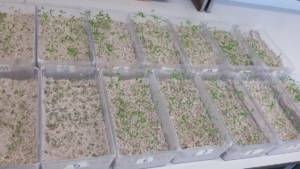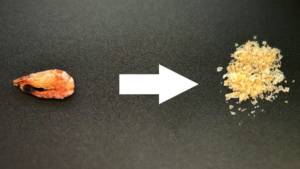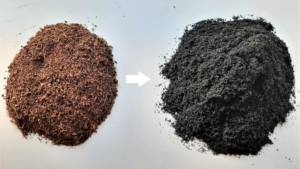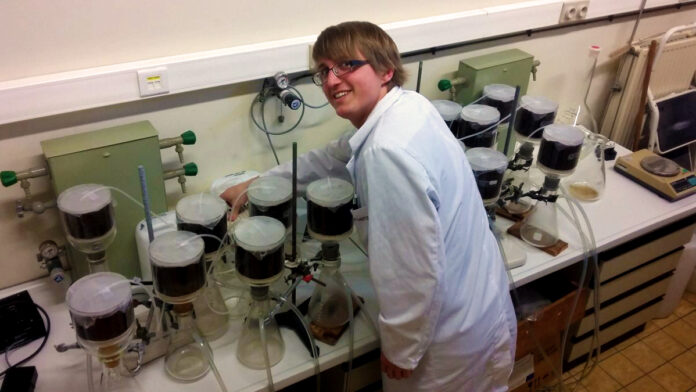Comparative greenhouse research on tomato and strawberry shows that yield remains the same even when Rockwool and a large part of the peat, respectively, are removed from the growing substrate and replaced by renewable or less-energy-intensive products chitin, biochar, and green compost. Bart Vandecasteele, the substrates specialist at Belgium’s ILVO research institute, has all the details, writes Spence Gunn in the November 2021 FloraCulture International Magazine.
As the floriculture industry becomes ever more dependent on soilless growing media, so the sustainability of these substrates comes further into the spotlight. Growers are being questioned about the environmental impacts – particularly on climate change – of the materials they use. In turn, they are scrutinising the commercial sustainability of ingredients such as peat, coir and wood fibre as their availability becomes restricted and prices climb.
Growing world demand
World demand for growing media is predicted to rise four-fold by 2050, driven by emerging markets, especially in Asia, and advances in production in controlled environments.
Peat demand alone could double at a time when many countries are starting to legislate against its extraction and use because of the implications for CO2 emissions. Market demand for coir (coconut fibre), one of the most widely used peat alternatives, is expected to soar seven-fold, while growers are competing with the heavily subsidised renewable fuels industry for wood fibre.
Blending ingredients and cutting disposal costs

Seedlings on a substrate including chitin.
It’s becoming clear that no single substrate can answer all technical, commercial and environmental demands. Instead, researchers are looking at how various ingredients can be blended to produce growing media with the right characteristics while avoiding reliance on any individual material.
A recent UK project, for example, resulted in a computer model to predict the performance of individual substrate ingredients or blends and used it to design media that performed as well as commercial peat-based products.
Research in a European EU-funded programme, Horti-BlueC, takes the thinking one stage further by considering ingredients and blends in terms of their suitability for reuse or recycling.
“Growers not only have the cost of purchasing the growing media, but of disposing of it after use,” says project leader Bart Vandecasteele, substrates specialist at Belgium’s ILVO research institute (one of the nine partners within Horti-BlueC see box). “So one aim is to help cut disposal costs.”
Vandecasteele suggests there are several ways to reuse a growing medium and thus ‘recycle’ the carbon it contains. For example, it can be directly reused or simply steam sterilised; it could be re-blended or used to produce biochar (a charcoal-like product suitable as a growing media amendment or substrate in small proportions); it could be composted to produce a new growing media ingredient, or the spent material spread on farmland where the carbon it contains would be sequestered or ‘locked up’ rather than dissipate to the atmosphere.
“Reuse of a medium containing peat is also a valuable option, provided a sustainable decontamination technique is used,” Vandecasteele adds. The imbalance between the supply and demand of substrates is now a real concern, he says. “That’s why we are investigating blended media. If one of the materials is in short supply or prices are going up, other materials in the blends we’ve tested can be used in higher proportions to reduce the overall price.” Substitutions could also be made in some cases.
Horti-BlueC trials

The trial blends, produced by Belgian company Agaris, were 45 per cent peat, 25 per cent wood fibre, 15 per cent green compost, 10 per cent coir and 5 per cent perlite for the strawberry crops.
Previous research narrowed down the choice of substrates for the Horti-BlueC trials to wood fibre, coir, bark, green compost and perlite, with biochar and chitin as amendments, primarily to aid nutrient management and crop health. The test crops were tomato and strawberry, chosen because their media specifications are exacting and because of the questions being asked about the sustainability of current commercial peat or coir strawberry substrates and rock wool for tomatoes.
The trial blends, produced by Belgian company Agaris, were 45 per cent peat, 25 per cent wood fibre, 15 per cent green compost, 10 per cent coir and 5 per cent perlite for the strawberry crops; and 40 per cent coir, 30 per cent wood fibre, 20 per cent bark and 10 per cent green compost for the tomatoes. These were tested with and without biochar or chitin as amendments at 2 or 4 grammes per litre. Biochar was also tested as a substrate ingredient at up to 10 per cent in the blends.
Vandecasteele says crops grown on the test blends have ‘scored similarly’ overall to those on the current commercial substrates. However, nutrition and irrigation still need some refinement and will be addressed in the remainder of the project, which finishes in 2022.
Work is also being completed on ways to cut the energy needed for biochar production while capturing the CO2 and waste heat for use in greenhouses; and on sourcing chitin, which can supply nutrients as well as stimulate plant pest and disease defences, from shellfish industry waste.
Important implications for ornamentals too
The project has important implications not just for tomato and strawberry growers but for the ornamentals sector worldwide, Vandecasteele says, “We have already successfully tested reused spent peat-based growing media from strawberry for container-grown chrysanthemums.”
“So we know spent media from one cultivation can be reused for other crops. However, the different fertiliser or fertigation strategies used in ornamentals may affect the prerequisites for the substrate blends, or the strategies themselves may need to be fine-tuned.
“The work on chitin and biochar is also relevant. Chitin may provide a significant amount of mineral nitrogen in the first weeks of cultivation and may enhance the plant defence system. Some types of woody biochar could be a bulk ingredient in growing media for ornamentals.”
The predicted growth in demand for growing media presents opportunities for the industry, he says. “The challenge is to get the mixtures of the future technically sound and well balanced, as well as sustainable. That also means renewable and preferably local raw materials.”
Biochar en chitine, new kids in town for potting soil?
Biochar is a very stable form of carbon that can be used as a bulk material in cultivation substrate. It is created as a residual product when plant materials are converted using the technique of pyrolysis: a chemical process at high temperatures of 400 to 700°C and low oxygen conditions, which means no combustion takes place. This by-product yields a black solid, similar to charcoal.


The biochars in the tests were produced by the Dutch ECN-TNO, based on wood, plant fibres such as flax straw and used cultivation substrates. In the production of biochar, both the heat released and the CO2 in the greenhouses can replace pure CO2 fertilisation and fossil fuel heating. The greenhouse trials showed that, compared to the classic reference substrates, cultivation substrates with biochar scored at least as well in yield, both for strawberry and tomato.
Chitin is found in crustacean by-products and is usually mined chemically. The Horti-BlueC project found that two streams could be useful as chitin sources: the shells of the North Sea shrimp (Cragnon Cragnon), the by-product of mechanical peeling, and the shells of the Chinese woolly crab (Eriocheir sinensis), an invasive species in Belgium’s ports and waters. Chitin mixed in as a substrate additive positively influences the microbial community around plant roots in the soil. When used in low doses, chitin appears to improve plant resistance to disease. But chitin can also release mineral nitrogen and thus replace artificial fertilisers.
More about Horti-BlueC
Horti-BlueC is an Interreg 2 Seas project in which ILVO and PCH have collaborated with a team including six scientific and industrial partners on both sides of the English Channel.
 The project aims at solving bottlenecks and proposing new solutions for more sustainable growing media in horticulture and upcycling by-products from current practices.
The project aims at solving bottlenecks and proposing new solutions for more sustainable growing media in horticulture and upcycling by-products from current practices.
Horti-BlueC receives funding from the Interreg 2 Seas programme 2014-2020 (European Regional Development Fund, contract No 2S03-046), and the Provinces of Antwerp and East Flanders are co-funding ILVO for this project.
Nine partners from Belgium, France, the Netherlands and the UK are involved: ILVO, Cato Engineering, Research Centre Hoogstraten, Agaris Group, ECN-TNO, Université de Lille, NIAB-EMR, ADAS UK Ltd and the University of Portsmouth.
At Valorisation chains – Horti-BlueC, you can find a wealth of texts and videos on the project’s different trials and research work.













